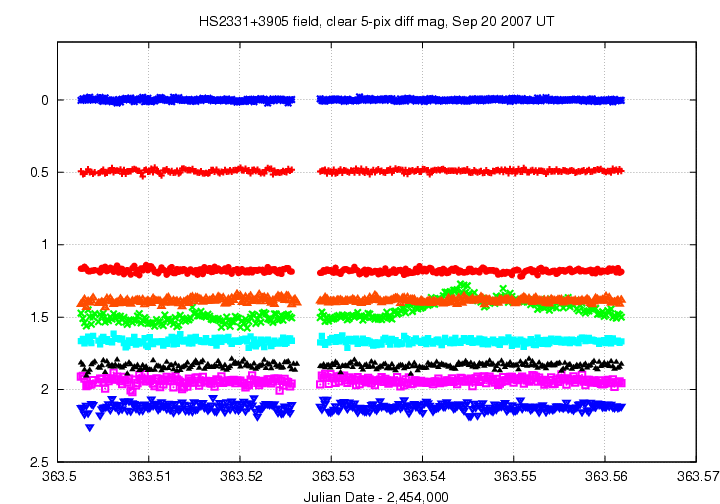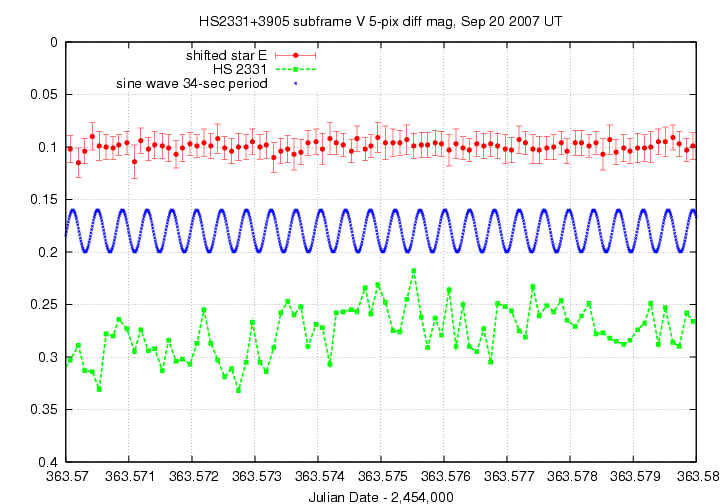
On the night of Sep 19/20, 2007 EDT, Joe Panzik and Michael Richmond used the RIT Observatory's 12-inch Meade telescope and SBIG ST8 CCD camera to monitor the cataclysmic variable star HS 2331+3905 (also known as V455 And), which was in the early stages of an outburst. This star is a cataclysmic variable similar to WZ Sge. For more information about it, read
The plan was out of the ordinary tonight. Based on a message from Joe Patterson , I decided to try to decrease the exposure time of our measurements. So far in this campaign, we had been making 10-second exposures and suffering from roughly 12-second readout time, leading to a roughly 22-second observing cadence. On this night, I would try to speed things up in two ways: changing filters (from V-band to unfiltered), and using subframe readout.
Notes from the night
This is a chart of the field based on images taken on earlier nights. Click on the chart for a larger version.
The chart has several of the brighter stars in the field labelled with letters, just to keep me straight as I perform the reductions. Some of these stars have good photometry, as mentioned in AAVSO Alert Notice 357 .
my
label RA Dec V B visual
----------------------------------------------------------------------------
23:37:10.49 +39:27:09.7 8.366 (0.014) 9.430 (0.025) 84
23:31:57.51 +39:19:43.4 9.248 (0.024) 9.969 (0.031) 93
23:33:05.63 +39:23:11.8 9.572 (0.029) 10.693 (0.059) 96
23:33:53.74 +38:57:22.6 10.007 (0.042) 11.115 (0.087) 100
23:34:46.69 +39:16:44.0 10.310 (0.043) 10.961 (0.054) 103
B 23:33:23.41 +39:17:58.8 10.481 (0.055) 11.167 (0.070) 105
A 23:34:23.38 +39:15:34.9 10.900 (0.078) 11.393 (0.076) 109
I'll use the star marked "A" to set the zeropoint of my differential magnitudes back onto the standard system, at least roughly.
I measured the instrumental magnitude of each star with aperture photometry, using a radius of 5 pixels = 9.3 arcseconds and sky defined by an annulus around each star. Following the procedures outlined by Kent Honeycutt's article on inhomogeneous ensemble photometry, I used all stars available in each image to define a reference frame, and measured each star against this frame.
Below is a graph of the scatter in differential magnitude versus magnitude in the ensemble solution.

HS 2331 is the star with large scatter at differential magnitude 1.5. The other two bright stars with slightly elevated scatter are not really variable, but lie near the edges of the frame; a small amount of drift causes them to grow fainter as they leave the chip. The brightest two comparison stars, "A" and "B", have a scatter of 0.007 and 0.010 mag, respectively, from their mean values.
Light curves for selected stars (HS 2331 and stars A - G) in the field are shown below. HS 2331, shown by light green crosses near the top, is clearly variable. The small gap for all stars occurred when we had to close the dome slit briefly to move a panel.

Here's a closeup of the variation in HS 2331 itself. I've also plotted the measurments of star "A", shifting them by 0.4 magnitudes so that they would fit nicely on the graph. Star "A" has errorbars to show the estimated uncertainty in each measurement.

I've made a table of the measurements themselves, with three different flavors of time. The differential magnitudes from the ensemble solution have been shifted so that star "A" in my chart, TYC 3231-533-1, has value 10.900. Remember: this data is unfiltered, but I am shifting the zeropoint to make star "A" match its V-band value.
Here's the start of the table.
# Measurements of HS 2331+3905 made at RIT Obs, Sep 20, 2007 UT, # made by Joe Panzik and Michael Richmond. # All data taken with 12-inch LX-200 + no filter + SBIG ST-8 CCD # no focal reducer, so at native f/10 # Each exposure 10 seconds long; tabulated times are midexposure # and accurate only to +/- 1 second. # 'mag' is a differential magnitude based on ensemble photometry # which has been shifted so TYC 3231-533-1 mag=10.900 # to match value from AAVSO Alert Notice 357. # # UT day JD-2,450,000 HJD-2,450,000 mag uncert Sep20.00259 4363.50259 4363.50698 11.881 0.016 Sep20.00279 4363.50279 4363.50718 11.918 0.016 Sep20.00297 4363.50297 4363.50736 11.948 0.017 Sep20.00317 4363.50317 4363.50756 11.970 0.017
Our system requires about 12 seconds to read out an entire frame; together with the 5-second exposure time, that leads to an interval of about 17 seconds between frames. In order to decrease this interval, I defined a subsection of the entire frame which contained the target star HS 2331+3905, its nearby neighbor "J", plus the bright star "E".

The subframe contains about 1/6 of the entire frame's area, so it can be read and stored in a FITS file on disk more rapidly. After taking about 1.5 hours of measurements in the ordinary way, I set up the subframe and took about one hour of data in this more rapid manner. The average interval between frames dropped to about 9.6 seconds.
I used the same aperture size (5 pixel radius) and the same method of analysis -- ensemble photometry -- to analyze the results of this subframe dataset. Since there were so few stars, the brightest one, star "E", was given a great deal of weight in the ensemble. Therefore, although its formal scatter from the ensemble mean is 0.005 magnitudes, I don't believe it; rather, I believe that the ensemble was being driven by star "E".
The light curve of the target and stars "J" and "E" is shown below.

Here's a closeup of one section of the subframe data, showing HS2331 and star "E", which has been shifted for clarity. I've also included a pure sine wave with a period of 34 seconds, since Joe Patterson mentioned the possibility of a cycle of this length. My eyes don't see any strong pattern with that period.

I've made a table of the measurements themselves, with three different flavors of time. The differential magnitudes from the ensemble solution have been shifted so that star "E" has the same value it did in the full-frame ensemble; that, in turn, was based on making star "A" = TYC 3231-533-1 have a magnitude of 10.900. Remember: this data is unfiltered, but I am shifting the zeropoint to make star "A" match its V-band value.
Here's the start of the table.
# Measurements of HS 2331+3905 made at RIT Obs, Sep 20, 2007 UT, # made by Joe Panzik and Michael Richmond. # All data taken with 12-inch LX-200 + no filter + SBIG ST-8 CCD # no focal reducer, so at native f/10 # Each exposure 5 seconds long; tabulated times are midexposure # and accurate only to +/- 1 second. # These measurements based on a small subframe with only two # nearby comparison stars. # 'mag' is a differential magnitude based on ensemble photometry # which has been shifted so TYC 3231-533-1 mag=10.900 # to match value from AAVSO Alert Notice 357. # # UT day JD-2,450,000 HJD-2,450,000 mag uncert Sep20.06441 4363.56441 4363.56880 11.870 0.010 Sep20.06451 4363.56451 4363.56890 11.894 0.008 Sep20.06464 4363.56464 4363.56903 11.904 0.006
Last modified 9/20/2007 by MWR.